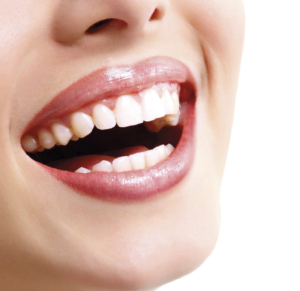Dr Isabelle Sabine Schwartz
The face is split into three parts: the upper, middle and lower thirds.
The lower third includes the mouth, lips, chin and oval. The mouth is marked out by the lips, which may be well defined or less so, plump or thin, and a variety of colours, ranging from pale to dark.
The teeth: a reflection of our personality
Our face lights up when we speak and smile. The smile is made up of the teeth, gums, lips and muscles. The teeth (unique to us), their shape, position, colour, size and volume reflect our personality. Each tooth has a symbolic representation: the central incisors represent our shape, the lateral incisors represent our femininity, and the canines represent aggression. More rounded teeth are more feminine, more convex teeth are more sensual, while thinner teeth are more discrete. The more prominent a tooth is, the more its charac-ter is projected.
The further back it is, the more introverted and shy the person seems. The more worn down the edges of the incisors are, the older the smile looks. But how worn the teeth are does not only depend on the person’s age. As we age, our teeth become more worn, but if they do not come together properly when we bite, things like teeth grinding can wear them down, the enamel disappears and leaves the den-tine exposed. Dentine is ivory, even yellow-coloured, which takes the brightness out of the smile and is synonymous with aging and old age. The brighter the teeth, the younger and more radiant the smile.
 The state of the teeth’s surface is important: rough, porous enamel does not reflect light. A polished, shiny surface holds on to light, and bright teeth are automatically more attractive. The position of the teeth is important: nothing could be uglier than a crowded, crooked smile. Conversely, straight teeth are a symbol of harmony. The thinner the lips, the sterner, more inflexible and serious we seem. Plump lips are alluring, they convey sensuality, generosity, emotion and sensitivity.
The state of the teeth’s surface is important: rough, porous enamel does not reflect light. A polished, shiny surface holds on to light, and bright teeth are automatically more attractive. The position of the teeth is important: nothing could be uglier than a crowded, crooked smile. Conversely, straight teeth are a symbol of harmony. The thinner the lips, the sterner, more inflexible and serious we seem. Plump lips are alluring, they convey sensuality, generosity, emotion and sensitivity.
The relationship between the lips, the gums and the teeth is also key. A gummy smile is not attractive: the lips should sit at the base of the teeth. The depth, volume and colour of the gums are important factors. The chin is also important to the patient’s profile. Its position is often determined by the pa-tient’s bite. Someone with mandibular retrognathia (an over-bite) is someone whose jaw is set back, whereas mandibular prognathism is when the jaw sits too far forward. Carbocalcic is a square jawline, fluocalcic is a longer jaw, and phosphoric people often have a weak jaw. After considering all of these points, it is easy to understand the role a dental surgeon can play in beautifying the lower face.
Straightening the teeth
A dentist can straighten the teeth, either with classic orthodontics or using new removable and transparent braces. The latter work miracles and patients can carry on with their life with no hang-ups. Dental surgeons can also straighten the teeth using implants: ceramic crowns or veneers. They can alter their colour and make your new teeth lovely and white, shiny and bright, as well as giving them an attractive and sensual shape. They can adjust the line of your smile by widening and transforming a tight smile into a lovely, wide beam.
They can also alter the position of the chin. The beauty of the lower face is also affected by the teeth’s height: worn teeth reduce the vertical bite, the lips become pinched and droop slightly, which ages you and makes you look severe. By replacing the teeth, the dentist can fill any gaps and thus plump up the sagging tissue in the lower face, as well as any hollows and drooping in the lips. Implants are a fantastic tool. We no longer need to resort to removable dentures, meaning you can laugh, smile and eat without any fear of losing your teeth! Dental surgeons play a fundamental role in beautifying and rejuvenating the lower face: plumping the lips, restoring their support structure and beautifying the smile with sensual, white teeth.
A smile is synonymous with pleasure and desire, so show off your pearly whites!
 Dr Isabelle Sabine Schwartz: Former university lecturer, odontologist, assistant at the S.C.D.T. University degree in surgical implantology and prosthetics. Former consultant expert for the Paris Court of Appeals. isabelle-sabine-schwartz.fr
Dr Isabelle Sabine Schwartz: Former university lecturer, odontologist, assistant at the S.C.D.T. University degree in surgical implantology and prosthetics. Former consultant expert for the Paris Court of Appeals. isabelle-sabine-schwartz.fr















